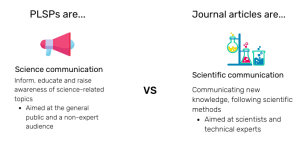Plain Language Summaries: what are they and how can they benefit early-career researchers?

What are Plain Language Summaries of Publications?
Plain Language Summaries of Publications (PLSPs) summarize the contents of a specialist research article(s) for non-specialist audiences. They can be a vital tool in helping share complex information like clinical trial results. They use non-technical language and make the most of images and infographics to help provide clear and understandable information to make complex concepts and data more digestible.
Future Science Group, which publishes the journal Bioanalysis, is keen to recognize and promote the vital role of medical and scientific research, and as such, introduced this new article type to its collection at the end of 2020. Since then, the Future Science Group collection have published numerous PLSPs to be used by all interested alike.
Examples of PLSPs
- A plain language summary of how well the single-dose Janssen vaccine works and how safe it is
- Vosoritide treatment accelerates bone growth in children with achondroplasia
- Antifungal drugs work together to treat germs causing fungal infections
Why are PLSPs necessary for early-career researchers?
Scientific, technological and medical advancements constantly influence our modern society, as individuals are keen to learn more and understand the science for themselves. Especially during the COVID-19 pandemic, individuals are becoming more and more interested in acquiring scientific knowledge, enabling them to make everyday decisions based on accurate and reliable information. This means publishing and making PLSPs easily accessible is vital for those who find typical research papers challenging to fully understand without a STEM background.
“Effective science communications inform people about the benefits, risks, and other costs of their decisions, thereby allowing them to make sound choices” – Baruch Fischhoff, Howard Heinz University Professor, Institute for Politics and Strategy, and Engineering & Public Policy, Carnegie Mellon University (PA, USA).
Communicating outside of the scientific community could also boost a researcher’s career, by expanding the impact of their latest results, creating new collaborative opportunities across sectors, giving a significant boost to their public profile and opening doors for future projects. This is important if you are kick-starting your career, as opportunities are vital to building your profile and getting your name out there.
Science communication is a valuable transferable skill for researchers, one that is becoming more important with the rise of digital communication via different channels and platforms.

Top tips for writing PLSPs
- Think about your audience. What is their level of scientific knowledge? What about your work will interest them?
- Get rid of STEM specific language. To improve readability amongst a non-scientific audience, you should change acronyms and field specific language.
- Explain what the study is about, what you found and what the impact is. Those outside of your specific area of science will need more context about what you studied and why it is relevant to them.
- Have somebody read your summary, who is not a scientist, and then have them explain your study to you. If they cannot do it, revise the summary for clarity.
Please visit www.plainlanguagesummaries.com to find out more or contact Laura Dormer if you are interested in publishing a Plain Language Summary of Publication in our journals.
